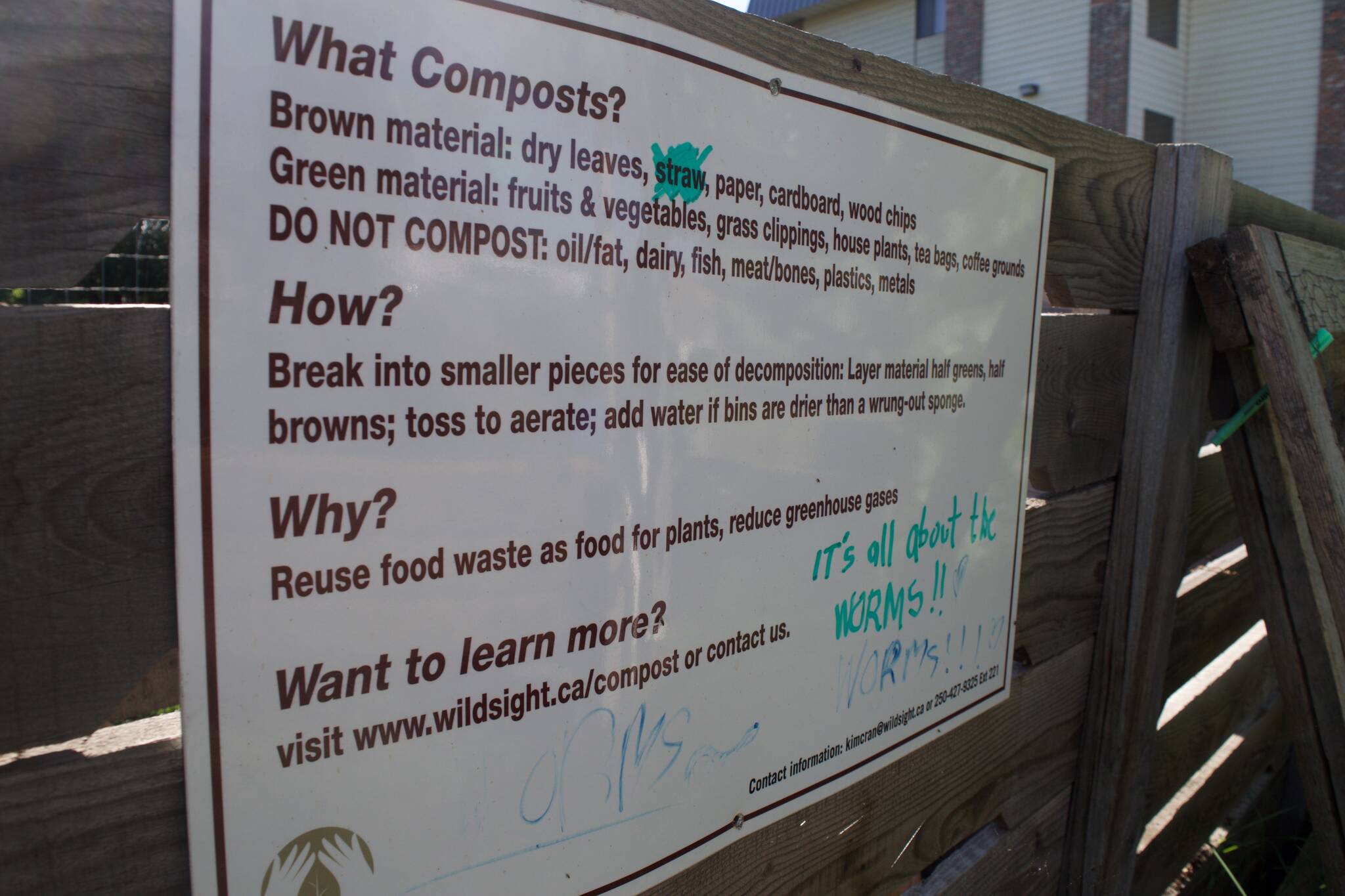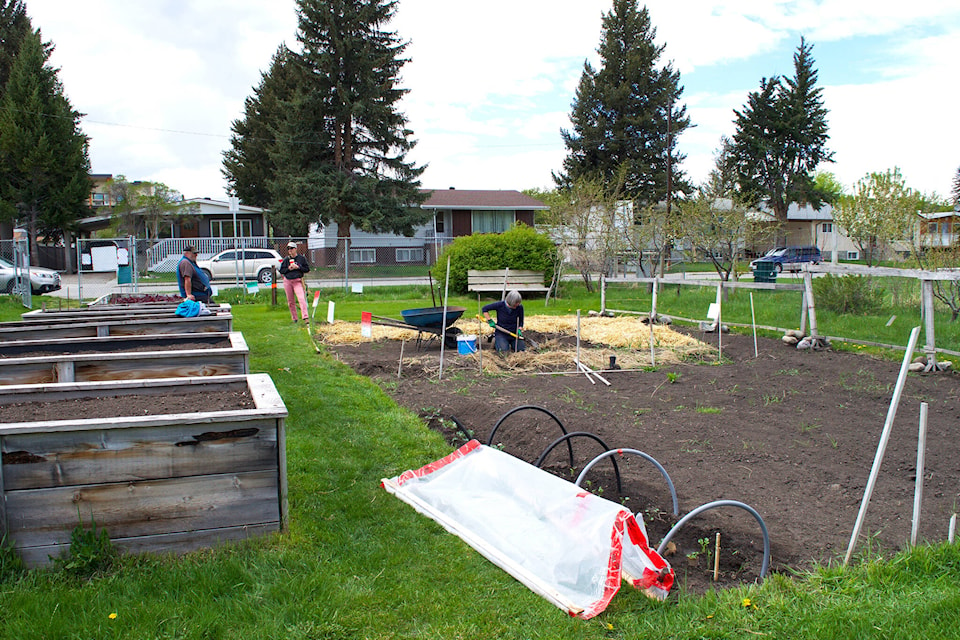Last week I spent some time at the Public Produce Garden (PPG) in Cranbrook, chatting with dedicated volunteers Pat Chisholm and Robert Holmes.
Chisholm, Holmes and the other volunteers have been working hard at the PPG for many years in may ways. One such way is with their compost system. And the PPG needs your kitchen scraps.
Let me tell you a bit about the community garden in general. The PPG, located beside MacKinnon Rotary Park on 18 Ave N, provides the community with food, a gathering space, educational opportunities about growing food and gardening practices, as well as opportunities for social connections.
The City gave them the land in 2011 and the garden opened the very next year. It runs entirely on volunteers.
Holmes is the compost specialist at the garden, and works hard to turn kitchen scraps, newspaper, leaves, and cardboard into beautiful soil.
There are ten main volunteers at the garden, but it is open to anyone in the community. The whole purpose of the garden is to teach people how to grow their own food and provide the space and tools to do so, and to help feed the needy. The PPG works in conjunction with the Cranbrook Food Action Committee, providing fresh food to social agencies such as the Food Bank.
Holmes explained that they have been working hard to restore the soil in the PPG, having been able to expand their planting areas at least 10 per cent over the past three years. They started with an area that was covered in grass, and have since created dozens of garden beds both raised and at ground level.
“A big piece of education in the garden is the importance of soil regeneration and gardening practices that are sustainable,” Holmes said. “There’s a real shift in attitude these days - the essence of growing on your own and purchasing within a small radius of where you live. This area is under-utilized and under-used, but has so much potential.”
They also practice lasagna gardening, which has proven to be an effective technique.
“We take clean cardboard (no stickers or tape) and lay it on the ground, then throw on roughage, like leaves, and add compost and soil on top,” Holmes said.
This method creates a bed without having to dig into the ground, and by next year, the cardboard, roughage and organic material can be turned and will be composted into the soil.
“We do it because it works. This idea is not new, it has been around for centuries, and it’s very simple,” Holmes said.
Chisholm says that the PPG is a place for community and connection. And you can see that the moment you step into the garden. There is love and effort put into every bed. There are systems in place. It’s a wonderful thing for the community.
“It’s a place for ideas, knowledge, the sharing of ideas and resources. We host workshops. But we also want to encourage people to use the space as a respite within the city,” Chisholm said. “We often have musicians come and play in the summer. It’s a place for exercise and activity.”
This is also why the PPG needs compost from the community. It’s a way to get involved, learn something new, but also contribute to a healthier planet. Why throw your kitchen scraps in the garbage when they can be turned into soil?!
The composting process is quite simple. The basics: mix green material with brown material and over time it turns into soil.
Greens include fruits and vegetables, grass clippings, house plants, tea bags and coffee grounds and filters. Brown materials are dry grass, dry leaves, newspaper, cardboard and wood chips. You can also compost things like wood ashes, egg shells and dryer lint. Things that cannot go in the compost include oil or fat, meat or dairy products, or plastics and metals.
There are directions at the PPG for where your food scraps should go.
Also note that this garden is not to be confused with the GROW garden located on 14th Ave. That garden, although also a wonderful community garden, operates like an allotment - where people purchase a plot to grow their kitchen garden in.
I’m a firm believer that change is affected on a community level; a neighbourhood level. And part of that includes practicing ways of lessening our ecological footprint. It’s fitting then that I was invited to the PPG as Earth Day approaches on April 22.
We, as individuals, can do many things to make that kind of change. Recycling. Composting. Riding our bikes or walking more often. Reducing our water use. Hanging our clothes to dry. Supporting local. Growing our own food. The list goes on.
Growing up in Ontario, I had curb-side compost and yard waste pickup for basically my entire life. We had weekly garbage and recycling pickup and bi-weekly yard waste and compost pickup.
It’s funny because B.C. is known to so many as a green-friendly province, but we only started curb-side recycling in Cranbrook six months ago. Many small communities are behind the eight-ball with these types of initiatives, mostly because of the infrastructure costs and logistics it takes to implement them.
That said, the provincial government has decided to help fund compost collection programs in Fernie, Kimberley, Invermere and Creston.
So where does Cranbrook fit in? Perhaps we will see a composting program in our future, but for now, we can do it on a smaller level. Get involved with the Public Produce Garden - or if you are able to - compost in your own backyard.
There are some concerns about compost becoming a wildlife attractant, but if your compost is set up properly, it shouldn’t smell. I’ve been composting for the past six years and have yet to have an issue with wildlife (touch wood).
Those who are interested in getting involved in the Cranbrook Public Produce Garden are invited to attend their spring meeting, taking place at the garden on Thursday, April 28th at 1p.m.

